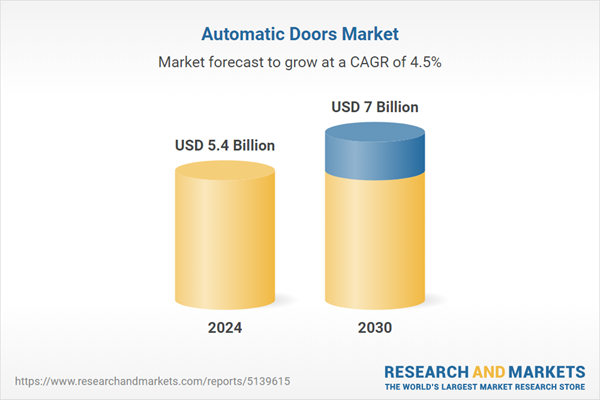Global Automatic Doors Market - Key Trends and Drivers Summarized
Why Are Automatic Doors Becoming a Staple in Modern Architecture?
Automatic doors have become a defining feature of modern architecture, seamlessly blending technology with functionality to enhance accessibility and convenience in various settings. These doors, commonly found in commercial buildings, hospitals, airports, and retail environments, are designed to open and close automatically using sensors, motion detectors, or other activation mechanisms. By eliminating the need for physical contact, automatic doors provide an effortless entry and exit solution that is particularly beneficial in high-traffic areas or for individuals with mobility challenges. As society increasingly prioritizes inclusivity, the adoption of automatic doors is seen as a critical component in creating barrier-free environments that cater to all users. Additionally, in settings like hospitals and food processing facilities, where hygiene is paramount, automatic doors contribute to maintaining sanitary conditions by reducing the potential spread of germs through touchless operation. As a result, these systems are not just a convenience but a necessity in many public and private spaces.What Technological Innovations Are Driving the Evolution of Automatic Doors?
The technological landscape of automatic doors has evolved significantly, driven by advancements that enhance their performance, safety, and energy efficiency. Modern automatic door systems are equipped with sophisticated sensors that can detect movement, heat signatures, and even the presence of obstacles, ensuring precise and reliable operation. The integration of smart technologies, such as IoT (Internet of Things) and AI (Artificial Intelligence), has further revolutionized automatic doors, enabling remote monitoring, predictive maintenance, and integration with building management systems. This allows facility managers to track door usage patterns, optimize energy consumption, and proactively address maintenance needs before they result in system failures. Moreover, the development of energy-efficient door operators and advanced insulation materials has made automatic doors more sustainable, contributing to the reduction of energy costs in climate-controlled environments. These technological innovations are not only improving the functionality and reliability of automatic doors but are also expanding their applications across a broader range of industries.How Do Market Demands and Regulatory Requirements Influence Automatic Door Adoption?
The adoption of automatic doors is heavily influenced by market demands for enhanced security, accessibility, and sustainability, as well as by regulatory requirements. In commercial and public buildings, there is an increasing expectation for seamless and secure access solutions that can handle large volumes of traffic without compromising safety. Automatic doors, particularly those integrated with access control systems, provide a robust solution that meets these needs. Furthermore, the trend towards green building certifications, such as LEED, is driving the demand for energy-efficient automatic doors that contribute to sustainable building practices. Regulatory standards, particularly those related to accessibility and fire safety, are also playing a crucial role in the widespread adoption of automatic doors. Compliance with the Americans with Disabilities Act (ADA) in the United States, for example, mandates that public buildings be equipped with accessible entryways, often fulfilled by automatic doors. Similarly, fire-rated automatic doors are required in many buildings to prevent the spread of fire and smoke, adding another layer of safety and compliance to these systems.What Factors Are Driving the Growth of the Automatic Doors Market?
The growth in the automatic doors market is driven by several factors that reflect both technological advancements and evolving market dynamics. The increasing demand for smart building solutions is a significant driver, as automatic doors are a key component of integrated building management systems that enhance energy efficiency, security, and user experience. The rapid urbanization and development of commercial infrastructure, particularly in emerging markets, are also expanding the addressable market for automatic doors, as new buildings are designed with modern access solutions in mind. Additionally, the heightened focus on hygiene and touchless technology in the wake of the COVID-19 pandemic has accelerated the adoption of automatic doors in healthcare, retail, and public transportation sectors. Regulatory requirements mandating accessibility and safety standards are further propelling market growth, as building owners and developers seek to comply with these mandates through the installation of automatic doors. Moreover, the ongoing innovations in sensor technology, AI, and IoT are enhancing the capabilities of automatic doors, making them more intelligent, efficient, and adaptable to a wide range of environments. These factors collectively ensure sustained growth in the automatic doors market as the demand for accessible, safe, and energy-efficient entry solutions continues to rise.Report Scope
The report analyzes the Automatic Doors market, presented in terms of units. The analysis covers the key segments and geographic regions outlined below.Segments: Type (Sliding Doors, Swing Doors, Revolving Doors, Folding Doors, Other Types).
Geographic Regions/Countries: World; United States; Canada; Japan; China; Europe (France; Germany; Italy; United Kingdom; and Rest of Europe); Asia-Pacific; Rest of World.
Key Insights:
- Market Growth: Understand the significant growth trajectory of the Sliding Doors segment, which is expected to reach US$2.6 Billion by 2030 with a CAGR of a 5.3%. The Swing Doors segment is also set to grow at 4.4% CAGR over the analysis period.
- Regional Analysis: Gain insights into the U.S. market, valued at $1.5 Billion in 2024, and China, forecasted to grow at an impressive 4.2% CAGR to reach $1.1 Billion by 2030. Discover growth trends in other key regions, including Japan, Canada, Germany, and the Asia-Pacific.
Why You Should Buy This Report:
- Detailed Market Analysis: Access a thorough analysis of the Global Automatic Doors Market, covering all major geographic regions and market segments.
- Competitive Insights: Get an overview of the competitive landscape, including the market presence of major players across different geographies.
- Future Trends and Drivers: Understand the key trends and drivers shaping the future of the Global Automatic Doors Market.
- Actionable Insights: Benefit from actionable insights that can help you identify new revenue opportunities and make strategic business decisions.
Key Questions Answered:
- How is the Global Automatic Doors Market expected to evolve by 2030?
- What are the main drivers and restraints affecting the market?
- Which market segments will grow the most over the forecast period?
- How will market shares for different regions and segments change by 2030?
- Who are the leading players in the market, and what are their prospects?
Report Features:
- Comprehensive Market Data: Independent analysis of annual sales and market forecasts in US$ Million from 2024 to 2030.
- In-Depth Regional Analysis: Detailed insights into key markets, including the U.S., China, Japan, Canada, Europe, Asia-Pacific, Latin America, Middle East, and Africa.
- Company Profiles: Coverage of players such as Assa Abloy AB, Dormakaba International Holding AG, Entrematic Group AB, GEZE UK Ltd., Gilgen Door Systems AG and more.
- Complimentary Updates: Receive free report updates for one year to keep you informed of the latest market developments.
Some of the 28 companies featured in this Automatic Doors market report include:
- Assa Abloy AB
- Dormakaba International Holding AG
- Entrematic Group AB
- GEZE UK Ltd.
- Gilgen Door Systems AG
- Portalp
- Rite-Hite Holding Corporation
- Royal Boon Edam International B.V. (Boon Edam)
- SHIPYARDDOOR PVC Fabric Door Systems
- Stanley Access Technologies LLC
Tariff Impact Analysis: Key Insights for 2025
Global tariff negotiations across 180+ countries are reshaping supply chains, costs, and competitiveness. This report reflects the latest developments as of April 2025 and incorporates forward-looking insights into the market outlook.The analysts continuously track trade developments worldwide, drawing insights from leading global economists and over 200 industry and policy institutions, including think tanks, trade organizations, and national economic advisory bodies. This intelligence is integrated into forecasting models to provide timely, data-driven analysis of emerging risks and opportunities.
What’s Included in This Edition:
- Tariff-adjusted market forecasts by region and segment
- Analysis of cost and supply chain implications by sourcing and trade exposure
- Strategic insights into geographic shifts
Buyers receive a free July 2025 update with:
- Finalized tariff impacts and new trade agreement effects
- Updated projections reflecting global sourcing and cost shifts
- Expanded country-specific coverage across the industry
Table of Contents
Companies Mentioned (Partial List)
A selection of companies mentioned in this report includes, but is not limited to:
- Assa Abloy AB
- Dormakaba International Holding AG
- Entrematic Group AB
- GEZE UK Ltd.
- Gilgen Door Systems AG
- Portalp
- Rite-Hite Holding Corporation
- Royal Boon Edam International B.V. (Boon Edam)
- SHIPYARDDOOR PVC Fabric Door Systems
- Stanley Access Technologies LLC
Table Information
| Report Attribute | Details |
|---|---|
| No. of Pages | 187 |
| Published | April 2025 |
| Forecast Period | 2024 - 2030 |
| Estimated Market Value ( USD | $ 5.4 Billion |
| Forecasted Market Value ( USD | $ 7 Billion |
| Compound Annual Growth Rate | 4.5% |
| Regions Covered | Global |









